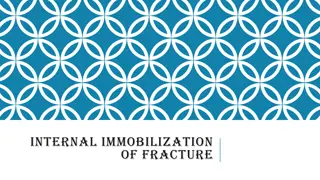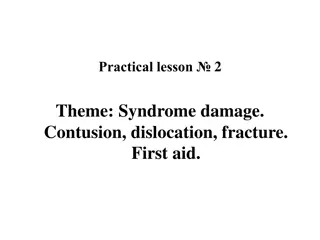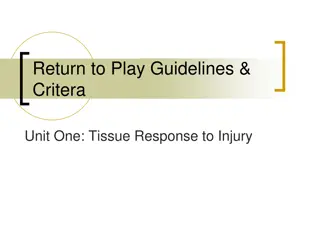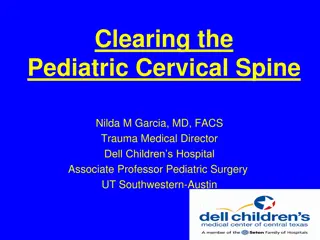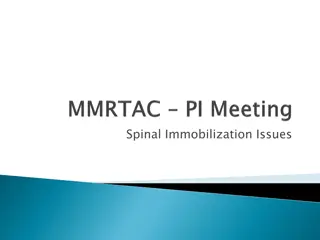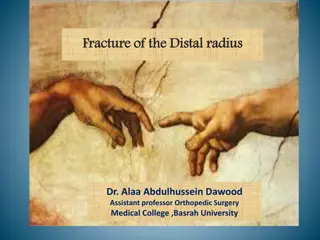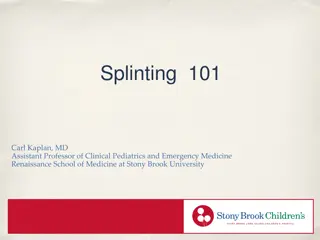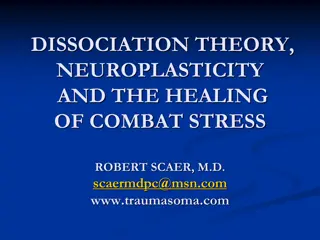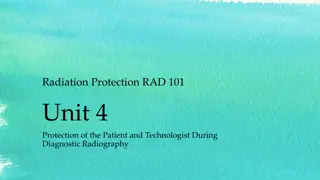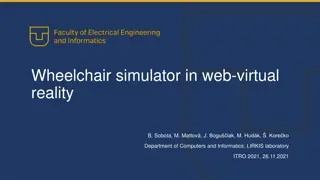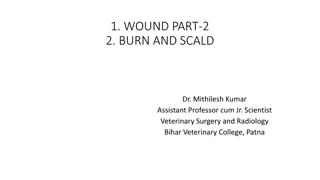Understanding Frozen Shoulder and Adhesive Capsulitis
Periarthritis of the shoulder, also known as adhesive capsulitis or frozen shoulder, is a condition characterized by pain, stiffness, and limited range of motion in the shoulder joint. Risk factors include immobilization, tendon inflammation, stroke, lung disease, diabetes, and more. Clinical featur
0 views • 24 slides
Introduction to Passive Movement in Physical Therapy
Passive movement in physical therapy involves movements generated by external forces, such as therapists or machines, for patients unable to move actively due to various conditions. The practice aims to prevent complications from immobilization and maintain joint health and tissue mobility. Passive
2 views • 20 slides
Methods of Internal Immobilization for Fracture Repair
Various methods of internal immobilization for fracture repair in animals include intramedullary pinning and nailing, Rush pins, cross pinning, screws, wires, and plate fixation. These methods provide stability and alignment for bone fractures, with success rates depending on the size and weight of
0 views • 21 slides
Enzyme Immobilization: Techniques and Applications in Industry and Healthcare
Enzyme immobilization involves confining enzymes on inert supports for stability and reuse, enhancing efficiency and cost-effectiveness. Historical events and examples illustrate various methods and applications. Chemical modifications, such as PEG addition, have shown increased enzyme activity. The
0 views • 34 slides
Immobilization of Enzymes in Biochemistry
Enzyme immobilization involves confining enzyme molecules to a distinct phase from substrates and products, attaching them to solid matrices for enhanced specificity and reduced inhibition. Inert polymers or inorganic materials are used as carrier matrices with methods like physical adsorption onto
0 views • 24 slides
Rehabilitation Considerations During the COVID-19 Outbreak
Rehabilitation services during the COVID-19 pandemic are crucial for continuing essential care and optimizing outcomes, especially for individuals with severe COVID-19 cases. Considerations for non-COVID-19 rehabilitation services must be maintained to address acute injuries, post-surgical recovery,
0 views • 14 slides
Practical Lesson on Syndrome Damage: Contusion, Dislocation, and Fracture First Aid
Learn the definitions, causes, and symptoms of contusion, dislocation, and fracture in this practical lesson. Discover the basics of first aid, types of immobilization, and principles of transport immobilization. Equip yourself with the knowledge and skills to perform specific first aid treatments f
0 views • 16 slides
Plant Tissue Culture: Historical Development, Techniques, and Applications
Plant tissue culture is an experimental technique that involves the in-vitro cultivation of plant cells to produce secondary metabolites, regenerate plants, and study organogenesis. This process allows for the maintenance of disease-free plant material, biosynthetic pathway tracing, and cell immobil
0 views • 21 slides
Settler Colonialism and Carcerality: Disrupting Indigenous Relationships and Territories
This study delves into the impact of settler colonialism on Indigenous peoples, focusing on the immobilization and movement imposed on them through carceral spaces. It explores the intersections of official and unofficial carceral spaces, shedding light on the disrupting effects on Indigenous relati
0 views • 8 slides
Return to Play Guidelines and Criteria for Athletes
Discover the critical steps involved in the return to play process for injured athletes, including tissue response to injury, re-injury rates with and without certified athletic trainers, and key stages like immobilization, range of motion, basic strength, speed, and sport-specific function. Learn a
0 views • 28 slides
Snake Bite Management Guidelines: Reassurance, Immobilization, Hospital Care
Snake bite management involves reassuring the victim, immobilizing the affected limb, and promptly transporting the individual to a hospital with snakebite treatment facilities. Local and systemic examinations are essential to assess the severity of envenomation, followed by necessary investigations
0 views • 12 slides
Pediatric Cervical Spine Evaluation and Clearance - Comprehensive Review
This informative content delves into the significance, assessment, and clearance of pediatric cervical spine injuries, emphasizing the stratification by age groups and the importance of early evaluation. It highlights the need for spinal clearance in all trauma patients, discusses the immobilization
0 views • 21 slides
Spinal Immobilization in Trauma: Case Study and Considerations
A 70-year-old male with trauma after falling 20 feet was managed at the ED, demonstrating tenderness in the mid thoracic spine and other injuries. Despite negative cervical spine imaging, the patient underwent interventions for spinal fractures. The decision to transfer without a backboard highlight
0 views • 34 slides
Distal Radius Fracture: Diagnosis, Management, and Complications
Distal radius fractures, particularly Colles fractures, are common injuries, often affecting elderly women due to osteoporosis. These fractures typically result from a fall onto an outstretched hand, causing dorsal and sometimes radial displacement of the distal radius fragment. Clinical features in
0 views • 32 slides
Splinting 101: Basic Principles, Materials, and Types of Splints
Learn the fundamental principles of splinting from Assistant Professor Dr. Carl Kaplan, covering indications, materials needed, and various types of splints such as short arm, volar, radial gutter, ulnar gutter, and thumb spica. Discover when to use each type for different orthopedic injuries and fr
0 views • 23 slides
Understanding Combat Stress: Dissociation Theory, Neuroplasticity, and Healing
Explore the roots of traumatization, the freeze response, hypnosis, and the importance of discharging freeze responses in combat stress healing. Discover how endorphins in trauma, memory mechanisms, and the impact of immobilization on survival play crucial roles. Gain insights into animal behavior a
0 views • 98 slides
Comprehensive Guide to Management of Fractures in Animals
This detailed guide covers the diagnosis and surgical treatment of humeral diaphyseal fractures, supracodylar fractures, and radial and ulnar fractures in animals. It includes information on immobilization techniques, diagnostic imaging, and surgical options for optimal management of bone injuries i
1 views • 21 slides
Radiation Protection in Diagnostic Radiography: Patient and Technologist Safety
Effective communication, immobilization, beam-limiting devices, beam filtration, gonadal shielding, exposure factors, IR combinations, good processing techniques, and reducing repeat radiographs are crucial for minimizing patient exposure during radiographic procedures. Equipment design features for
0 views • 49 slides
Intracytoplasmic Sperm Injection (ICSI) Procedure Overview
This detailed guide outlines the step-by-step process of performing an Intracytoplasmic Sperm Injection (ICSI) procedure, including sperm selection, oocyte injection, and fertilization confirmation. It covers essential techniques such as micromanipulation station setup, sperm immobilization, and emb
0 views • 8 slides
Wheelchair Simulator in Web Virtual Reality
The presentation discusses the development of a wheelchair simulator using web-based virtual reality technology, particularly on the LIRKIS G-CVE platform. This system aims to provide a virtual environment for individuals who need to learn wheelchair skills due to temporary or permanent immobilizati
0 views • 13 slides
Factors Affecting Delayed Wound Healing and Remedies
Understanding the factors that can delay wound healing is crucial for effective treatment. Bacterial infection, foreign bodies, devitalized tissues, desiccation, and inadequate blood supply are common culprits. Additionally, issues like hematoma, improper tissue apposition, and lack of immobilizatio
0 views • 15 slides


